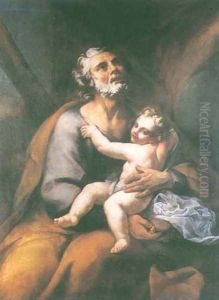Francesco Boccacino Paintings
Francesco Boccacino was an Italian painter of the Baroque period, born in 1672 in Cremona, Italy. He was the son of the well-known painter Boccaccio Boccaccino and is often considered as carrying on the artistic tradition of his father. Francesco was active primarily in his native city, where he contributed to the local artistic landscape with his religious works and frescoes. His style was influenced by the dominant trends of the Lombard and Emilian schools, and he was particularly known for his skillful use of color and light.
Boccacino's work typically featured religious themes, which was common for the period, with a focus on dramatic narratives and emotional expressions in his figures. He painted several works for churches in Cremona and the surrounding areas, including altarpieces and frescoes. His art was characterized by a blend of naturalism and the Baroque flair for the dramatic. Despite living in the shadow of his more famous father, Francesco managed to carve out a reputation for himself, and his works were appreciated for their devotional intensity and technical proficiency.
Little is known about Francesco Boccacino's training, but it is likely that he learned the basics of painting in his father's workshop. During his career, he did not gain the same level of fame as contemporaries such as Giovanni Battista Tiepolo or Francesco Guardi, but he was respected in his region for his contributions to church decorations and his role in maintaining the artistic heritage of his city. Boccacino's death occurred in 1750, and while he may not have achieved widespread recognition, his works remain as examples of the local artistic production of Cremona during the Baroque era.
